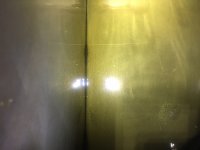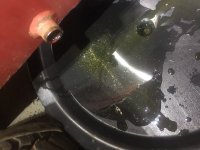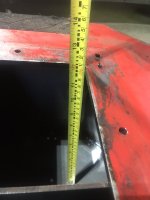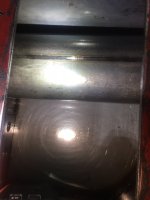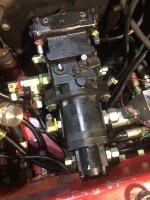i want to give an update on the tram pump. sorry its taken so long. i called terry and he was able to fix it. he said it got damaged and scored by metal fragments. during the call i realized where the metal fragments came from. during the last snow storm in late march in which we got 3 ft of snow, i was plowing the driveway when i heard a squealing noise and then the tractor wouldnt go back up the driveway. the front left wheel motor siezed up,so i had to limp it to the side to get it off the driveway during the storm. i then got the wheel motor fixed and used it until the metal tore up the tram motor. anyway, since there still may be metal filings in the tank, i decided to drain the oil and this is what i found at the bottom of the tank and on the used oil container . after cleaning it up i remembered someone who had put magnets on rods into their tank. so i'm going to find that post and order some. i measured from the bottom of the tank to the top to make sure i get the right length. the tram motor is coming back next week. i will change the hydraulic oil filter when everything is all back together to make sure i get all the metal filings. thanks
You are using an out of date browser. It may not display this or other websites correctly.
You should upgrade or use an alternative browser.
You should upgrade or use an alternative browser.
pt1430 wont go forward or backward basically stuck in front yard
- Thread starter kjm3232
- Start date
- Views: 9841
More options
Who Replied?
/ pt1430 wont go forward or backward basically stuck in front yard
#41
ponytug
Super Member
Yikes. I hope that you can salvage things. This is my personal nightmare.
Don't forget to flush all the motors and hoses extensively before putting your pump back in service. The drive system largely recycles the oil between the tram pump and the wheel motors. If you found metal in the tank, it may be in your cylinders as well.
This hurts just to look at.
All the best,
Peter
Don't forget to flush all the motors and hoses extensively before putting your pump back in service. The drive system largely recycles the oil between the tram pump and the wheel motors. If you found metal in the tank, it may be in your cylinders as well.
This hurts just to look at.
All the best,
Peter
marrt
Platinum Member
Put a strong magnet where the metal fragments "pile up" in the tank. That's where the "swirl" from incoming hydraulic fluid allows the fragments to gather.
You’re not going to like this next comment. I made a post, years ago, about creating a cheap "filter assembly" for the pump/motor hydraulic circuit. Remember, this circuit is NOT filtered by your main hydraulic filter (except when fluid bypasses inside the variable displacement pump…which is why you saw some particles in your reservoir). A catastrophic motor failure is a worst-case scenario for a closed loop hydraulic design. Everything in the loop gets contaminated. If you don't filter this circuit, you will still have a lot of material going round and round. In a commercial machine, they even have ways to drag a device through all the hoses to clean out particles. For a PT, the loop is so short that this isn’t necessarily required. But filtering the loop is, in my opinion. It will take forever for the particles to bypass and get back to the reservoir otherwise. It’s not hard or super expensive to buy the high-pressure filter and other parts. Once you have the filter assembly made, it’s a simple matter to disconnect the hoses from one motor and connect the filter. Jack the tractor up, then use the tram to forward and reverse the flow. The filter design I posted uses check valves to ensure the flow through the filter itself is always in the right direction. Reversing the flow, from time to time, creates a better chance to dislodge any particles trapped in the hoses.
Now, to be clear, Terry will likely tell you to not worry about it. That's because it's a bit of effort to build a high-pressure filter assembly as the parts must be purchased and assembled correctly. Also, ANY high-pressure hydraulic assembly involves some risk because there’s the possibility of a high-pressure leak, causing physical harm. Most companies would not make a recommendation where they cannot control the risk. But, in the far past, PT did offer a filter assembly for this purpose. Also, almost all professional commercial companies will filter a closed loop circuit any time it's opened for maintenance.
What are the downsides to not filtering the circuit? Much reduced life for the variable displacement pump and motors. Now, if you don’t use the tractor that much, and it’s not critical to avoid down time (e.g., it’s not used commercially), and you don’t mind paying for a pump rebuild every 200-400 hours, then you should be good. It’s a perfectly reasonable compromise to make. I’m not making a recommendation…just trying to ensure you have the information to do your own research and understand the tradeoffs.
You’re not going to like this next comment. I made a post, years ago, about creating a cheap "filter assembly" for the pump/motor hydraulic circuit. Remember, this circuit is NOT filtered by your main hydraulic filter (except when fluid bypasses inside the variable displacement pump…which is why you saw some particles in your reservoir). A catastrophic motor failure is a worst-case scenario for a closed loop hydraulic design. Everything in the loop gets contaminated. If you don't filter this circuit, you will still have a lot of material going round and round. In a commercial machine, they even have ways to drag a device through all the hoses to clean out particles. For a PT, the loop is so short that this isn’t necessarily required. But filtering the loop is, in my opinion. It will take forever for the particles to bypass and get back to the reservoir otherwise. It’s not hard or super expensive to buy the high-pressure filter and other parts. Once you have the filter assembly made, it’s a simple matter to disconnect the hoses from one motor and connect the filter. Jack the tractor up, then use the tram to forward and reverse the flow. The filter design I posted uses check valves to ensure the flow through the filter itself is always in the right direction. Reversing the flow, from time to time, creates a better chance to dislodge any particles trapped in the hoses.
Now, to be clear, Terry will likely tell you to not worry about it. That's because it's a bit of effort to build a high-pressure filter assembly as the parts must be purchased and assembled correctly. Also, ANY high-pressure hydraulic assembly involves some risk because there’s the possibility of a high-pressure leak, causing physical harm. Most companies would not make a recommendation where they cannot control the risk. But, in the far past, PT did offer a filter assembly for this purpose. Also, almost all professional commercial companies will filter a closed loop circuit any time it's opened for maintenance.
What are the downsides to not filtering the circuit? Much reduced life for the variable displacement pump and motors. Now, if you don’t use the tractor that much, and it’s not critical to avoid down time (e.g., it’s not used commercially), and you don’t mind paying for a pump rebuild every 200-400 hours, then you should be good. It’s a perfectly reasonable compromise to make. I’m not making a recommendation…just trying to ensure you have the information to do your own research and understand the tradeoffs.
marrt
Platinum Member
You beat me to it Peter. I started working on my post this am and got called away.Put a strong magnet where the metal fragments "pile up" in the tank. That's where the "swirl" from incoming hydraulic fluid allows the fragments to gather.
You’re not going to like this next comment. I made a post, years ago, about creating a cheap "filter assembly" for the pump/motor hydraulic circuit. Remember, this circuit is NOT filtered by your main hydraulic filter (except when fluid bypasses inside the variable displacement pump…which is why you saw some particles in your reservoir). A catastrophic motor failure is a worst-case scenario for a closed loop hydraulic design. Everything in the loop gets contaminated. If you don't filter this circuit, you will still have a lot of material going round and round. In a commercial machine, they even have ways to drag a device through all the hoses to clean out particles. For a PT, the loop is so short that this isn’t necessarily required. But filtering the loop is, in my opinion. It will take forever for the particles to bypass and get back to the reservoir otherwise. It’s not hard or super expensive to buy the high-pressure filter and other parts. Once you have the filter assembly made, it’s a simple matter to disconnect the hoses from one motor and connect the filter. Jack the tractor up, then use the tram to forward and reverse the flow. The filter design I posted uses check valves to ensure the flow through the filter itself is always in the right direction. Reversing the flow, from time to time, creates a better chance to dislodge any particles trapped in the hoses.
Now, to be clear, Terry will likely tell you to not worry about it. That's because it's a bit of effort to build a high-pressure filter assembly as the parts must be purchased and assembled correctly. Also, ANY high-pressure hydraulic assembly involves some risk because there’s the possibility of a high-pressure leak, causing physical harm. Most companies would not make a recommendation where they cannot control the risk. But, in the far past, PT did offer a filter assembly for this purpose. Also, almost all professional commercial companies will filter a closed loop circuit any time it's opened for maintenance.
What are the downsides to not filtering the circuit? Much reduced life for the variable displacement pump and motors. Now, if you don’t use the tractor that much, and it’s not critical to avoid down time (e.g., it’s not used commercially), and you don’t mind paying for a pump rebuild every 200-400 hours, then you should be good. It’s a perfectly reasonable compromise to make. I’m not making a recommendation…just trying to ensure you have the information to do your own research and understand the tradeoffs.
You're right about the cylinders. Those gear pump assemblies are totally unfiltered, correct? Only the main VDP charge pump. So, any particles in the reservoir will make it into those circuits. On the positive side, gear pumps are pretty durable. Thoroughly cleaning the tank, new fluid, magnets in the tank, and using a filter assembly for the pump/motor circuit is a good compromise…without a LOT of work and perhaps expense. Of course, it is possible to remove and clean all the cylinders and get new hoses (I’d buy new as it would be pretty hard to clean them thoroughly). A big project though. Reminds me of the project “what’s his name” did rebuilding an 1845 after a fire in the engine compartment years ago (Moss will remember his name). All doable, but not easy and not fast.
ponytug
Super Member
@marrt Spot on posts!
I remember digging around after your initial posts and finding an off the shelf high pressure filter that was bidirectional with internal check valves to ensure that the flow through the filter was unidirectional. Unfortunately, the project dropped down my do list, and I no longer remember the vendor.
Something like this one;
 www.hyprofiltration.com
www.hyprofiltration.com
In searching for that, I came across this magnetic suction filter, which looks intriguing, but I haven't dug into it;
$100 on eBay..
@kjm3232 I think that you are referring to @SpringHollow's tank upgrade:
General tractor modifications.
Filter Cart
Tank Magnets
All the best,
Peter
I remember digging around after your initial posts and finding an off the shelf high pressure filter that was bidirectional with internal check valves to ensure that the flow through the filter was unidirectional. Unfortunately, the project dropped down my do list, and I no longer remember the vendor.
Something like this one;
PFHB High Pressure Full Flow Bi-Directional Filter Assemblies Overview
PFHB high pressure filter assemblies - designed for applications where flow direction changes and fluid must be filtered with full flow in both directions
In searching for that, I came across this magnetic suction filter, which looks intriguing, but I haven't dug into it;
$100 on eBay..
@kjm3232 I think that you are referring to @SpringHollow's tank upgrade:
General tractor modifications.
Filter Cart
Tank Magnets
All the best,
Peter
- Joined
- Aug 31, 2001
- Messages
- 66,020
- Location
- South Bend, Indiana (near)
- Tractor
- Power Trac PT425 2001 Model Year
I remember a couple engine fires. One was KentT's 425 here:

 www.tractorbynet.com
www.tractorbynet.com
Sedgewood had a fire in an 1845 way back in 2003. Links to photos are long gone.

 www.tractorbynet.com
www.tractorbynet.com

When one door closes, another opens....
I was tilling up the harvested parts of my garden late Saturday evening, and stopped to clean weeds/grass out of the tines. When I tried to restart the old, modified (MossRoad vintage) PT-425 with almost 1400 hours on it - it backfired and caught on fire. While I can't pinpoint the cause of...
Sedgewood had a fire in an 1845 way back in 2003. Links to photos are long gone.

FIRE! In the engine room!
5pm Friday, out mowing for the first time this season, smell smoke. Where there's smoke there's fire. I'm still a bit rattled - details later. visit http://www.coxontool.com/tractor/pt1845.php for some pictures. Sedgewood
PowerTracManiac
Silver Member
Spring hollows upgrades as posted above by ponytug are outstanding. I am surprised at the number of metal filings in the photo of the magnet system?
Reminds me again how little I know about my 1460.
When u posted about filtering the fluid I didn't realize that the main filter doesn't filter that fluid?
Does anyone have a complete manual of the 1460 hydraulic operational system? Obviously, I don't really understand the inner workings of my machine.
I have suggested a workshop/meetup at PT in the past to learn about our machines but that idea didn't get any traction.
Thank you to kjm3232 who posted about the seized motor and sorry about your trouble.
Now, if I ever have a motor problem, I will know to filter/flush the system as best as possible prior to continuing back on the machine to prevent damage to other components.
Reminds me again how little I know about my 1460.
When u posted about filtering the fluid I didn't realize that the main filter doesn't filter that fluid?
Does anyone have a complete manual of the 1460 hydraulic operational system? Obviously, I don't really understand the inner workings of my machine.
I have suggested a workshop/meetup at PT in the past to learn about our machines but that idea didn't get any traction.
Thank you to kjm3232 who posted about the seized motor and sorry about your trouble.
Now, if I ever have a motor problem, I will know to filter/flush the system as best as possible prior to continuing back on the machine to prevent damage to other components.
want to give a uptate on it all.sorry for the delay but had to wait a bit between alot of main job working late, my mechanic farmer friend same thing. anyway, i got the whole assembly (tram pump, pto pump etc) back. while he was holding it i attached the bottom hoses but then we had issues trying to get the tram pump assembly to mate with the engine. while we were trying to figure out how best to match everything up, i noticed that PT installed the pto pump 180 degrees reversed. the port with the yellow zip tie should be on the right side of the picture. so we stopped there and next day i told Terry what was reversed and the problem in getting it to mate up. he said undue the 2 bolts seperate the pto pump, then we should be able to mate the tram pump to the engine housing. so last nite we did that. got the tram pump in and bolted to the engine. then we tried to install the pto and last pump to the tram pump and couldn't get it in. the pto shaft and the last pump and cap was hitting the end of the tank. we needed another 1/4 to 1/2 inch clearance to get it to go in correctly. Terry said not to take off that last cap because that was the pressure relieve circuit. so now we had to get creative and figure out a way to gain that extra 1/2 in clearance. my mechanic farmer friend suggested that we unbolt the engine slide it back and that would give us the space needed. so that's what we did. unbolted the engine, slid it back just enough to get the pto pump in, bolted it in and then slid the engine forward and bolted that back down. he left and today i changed the hydraulic oil filter and added some magnets to the outside of the filter. finished adding the inline fuel cutoff switch so i dont have to drain the tank when i'm replacing the inline fuel filter, i'm going to be ordering some hydraulic oil tank magnets next week. i then bled the air out of the system. so after all that, started the tractor and drove it back and forth in and out of the garage. stopped to see if there were any leaks and didn't see any. so hopefully tommorrow will do the same to make sure there is no slow leaks and then back to using it. hopefully if this happens to someone else they have an idea of what to do to fix it. my ? to all of you if you had to get your tram/pto pump repaired did you have enough space in the engine compartment to get it back in without moving the engine back? thanks again for all your suggestions in trying to get this fixed.
Attachments
marrt
Platinum Member
One question...do you know the purpose of the capped fitting on top of the tram pump? Perhaps it's to connect a pressure gauge?
Regarding magnets, make sure you get the "high temperature" neodymium magnets. One example is DX06SH at K&J Magnetics. Standard neodymium magnets start to degrade at higher temperatures, such as experienced in the hydraulic tank.
Regarding mounting procedure, I haven't delt with a 1430. However, for the later 425's, it's very helpful to unmount the engine to attached the pump assembly. One can lift the engine and pump assembly at angles and "fold" them together. It's a little tricky at first but works like a charm once you get the hang of it. Of course, some type of winch is necessary to complete this maneuver. I clamped a 4x4 to the ROP and used a come-a-long connected to the engine.
Regarding magnets, make sure you get the "high temperature" neodymium magnets. One example is DX06SH at K&J Magnetics. Standard neodymium magnets start to degrade at higher temperatures, such as experienced in the hydraulic tank.
Regarding mounting procedure, I haven't delt with a 1430. However, for the later 425's, it's very helpful to unmount the engine to attached the pump assembly. One can lift the engine and pump assembly at angles and "fold" them together. It's a little tricky at first but works like a charm once you get the hang of it. Of course, some type of winch is necessary to complete this maneuver. I clamped a 4x4 to the ROP and used a come-a-long connected to the engine.
martt, the capped fitting is where a hose actually connects to. we hadn't got to that point yet because we still had to pull the pto pump out, get the tram pump mated to the engine, rotate the pto pump 180 degrees to get the correct hose ports on the correct sides. i did order those magnets you had listed from k & j magnetics. i believe that the only way to remove the tram pump/pto pump etc i will have to take the engine motor mount bolts out, move the engine back up to a 1/2 inch in order to gain the space to either remove it or reinstall the hydraulic pumps. thanks again
